Download it Now
Below you can access The Art of the Flower audio tour. Or you can download the app directly to your Apple iPhone or Android Smartphone here!
Tour Stop: 1
Introduction to The Art of Flower
I’m Mitchell Merling, the Paul Mellon Curator and Head of the Department of European Art at VMFA, and co-curator of Van Gogh, Manet, and Matisse: The Art of the Flower.
Artists have made paintings of flowers since the Renaissance, but the genre of floral still life painting was reinvented by French artists during the 19th century. The Art of the Flower showcases 65 floral still lifes representing almost two centuries of exploration and experimentation in France, from the middle of the 18th century to the first decades of the 20th. Floral still lifes have always been appreciated for their beauty, but this exhibition also seeks to convey their wide range and the ambition of artists working in this traditional genre.
I’m joined on this audio tour by my co-curator, Dr. Heather MacDonald, the Lillian and James H Clark Associate Curator of European Art at the Dallas Museum of Art. On this tour, walk through the galleries with Heather and me as we discuss key works in the exhibition.
Van Gogh, Manet, and Matisse: The Art of the Flowers is co-organized by the Virginia Museum of Fine Arts and the Dallas Museum of Art. The exhibition is supported by an indemnity from the Federal Council on the Arts and the Humanities, and is presented at VMFA with generous support from Altria Group.
We hope you enjoy the exhibition and thank you for visiting VMFA. Close
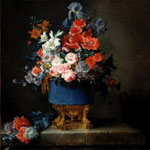
Tour Stop: 2
VALLAYER-COSTER, Bouquet of Flowers in a Blue Porcelain Vase
Oil on canvas
Dallas Museum of Art, Foundation for the Arts Collection, Mrs. John B. O’Hara Fund and gift of Michael L. Rosenberg, 1998.52.FA
Anne Vallayer-Coster was an artist who was extremely adept at bringing together many influences, many artistic influences. In this painting, the bouquet of flowers itself is very clearly referencing the flower painting of Dutch precedence; Dutch seventeenth century painters who made these kinds of extremely lush, extravagant bouquets full of beautiful specimen flowers—peonies and irises. So on the one hand, there is this reference back to the seventeenth century tradition whose wonderful northern still-life painters… She was also an artist that was steeped in modern luxury goods that were manufactured in Paris.
She had actually grown up within the manufactory, the Gobelins, which was the royal seat of manufacturing, not just tapestries, it’s best known for its tapestries, but also furniture and all kinds of luxury goods for the crown. Her father was a goldsmith so she really grew up knowing that world of luxurious manufactured goods that were made for the court and for the most wealthy consumers. You see that in the tension that she lavishes on this incredible blue porcelain vase, in which the bouquet is presented. It’s not just a piece of everyday porcelain.
Here, what we’re seeing is probably Asian porcelain that’s been mounted in guilt bronze mount that probably would have been made in Paris. These were extremely, technically sophisticated mounts that attached to the porcelain and made it into an even more luxurious object than it was. So we know that this was a real object that she would have seen—that she knew—and that she’s describing because it’s a modern object, it’s a fashionable object, it’s a luxury object, and it becomes this perfect foil for an incredible bouquet that’s showing off her skill and the art of the past, as well.
Anne Vallayer-Coster was a particularly interesting painter because she was one of the few, there were only four female artists ever admitted at any one time into the French Academy before the Revolution. She occupied a very special and unusual role in the public world of the art in France in the 1770’s and 80’s. I think that the obvious ambition of these paintings—their importance, their scale, their luxury—is perhaps an indication of how seriously she took that public role.
To me, the scale and ambition of this painting speaks to a variety of concerns that we’ll encounter throughout the exhibition, namely the ambition of flower painters to go beyond the mere application of nature and to present themselves as creators of images on a par with that of figure painters who are considered by bodies, like the Academy, to be superior because their painting involves the employment of the artists imagination, particularly like to focus the viewers attention, first on the extensive nature of the painting as itself an exquisite object.
Flower paintings, especially as exemplified by Dutch precursors such as Jan van Huysum or traditionally collected only by the very wealthy and are usually aristocratic or royal patrons. This was certainly the case with Vallayer-Coster, as well. Secondly, the skill with which this large painting is managed is incredibly striking because though is seems very straight forward and simple composition, it is a large painting with the artist very carefully choosing where to put touches of color in order to create patterns, in order to focus our attention on the preciousness of the flowers, the preciousness of the vase, and even the luxurious nature of the marble ledge on which it’s mounted. We’re looking at a hugely ambitious, complex and also very expensive painting. Close
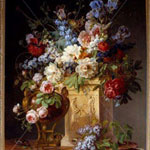
Tour Stop: 3
SPAENDONCK, Basket of Flowers on an Alabaster Pedestal
Basket of Flowers on an Alabaster Pedestal, 1785
Oil on canvas
Musée national du château de Fontainebleau, MR 2596
One of the interesting things about looking at flower painting in France at the end of the 18th century is how much it was dominated by artists who were not French by birth but had come there, come to Paris from the Netherlands or from Belgium and brought with them a really profound understanding of the northern flower painting tradition and that is certainly true for Gerard van Spaendonck who came to Paris quite young and was from a rather modest background of decorative painters.
Through his training and the people he met in Paris, was able to become one of the most lustrous flower painters of his age, the royal appointment, and indeed this painting was probably very likely commissioned by King Louis XVI to commemorate his royal appointment as the leading flower painter of his time. It was a painting that was intended for public exhibition at the salon where it was presented in 1785.
One of the features that this painting in particular exemplifies and shares with other paintings in this room is the very precise technique employed by van Spaendonck that is used by other artists that are called, rightly or wrongly, Franco-Dutch. They are, as you say, artists who are born in the north but made their careers in Paris, France, and continue to employ this very precise idiom in which each detail the viewer can savor, and is meant to savor the artist’s ability to portray each individual texture, each individual color, and every kind of surface imaginable.
Yeah, and I think that the pleasure of looking at pictures like these is really important. I think, you know, often when we think about Dutch still life painting there is a strong suggestion of moralism, often there are references included to sort of death, these sort of vanitas elements that we’re reminded of the fleeting nature of life. You see a lot less of that certainly in late 18th century French flower painting as much as it might draw in those sources. These are paintings that are so much about the sheer sort of delight in not just nature but the artist’s skill in translating nature. When the critics were seeing these paintings for the first time the most common thing they all were saying is it’s more real than nature itself.
I think what is important to remember with painters like Gerard van Spaendonck and a number of other artists in this first section of the exhibition is that their principle training was really as botanical illustrators, and at this moment artists really did both things. They both worked in a scientific context describing flowers scientifically, we should say for botanical publications, and also were making these kinds of more richly literary and illusive paintings for exhibition contexts like the Salon.
So that might seem a bit counter intuitive today where we feel that the arts and the sciences often aren’t in an immediate dialogue. But certainly for flower paintings at the end of the 18th century it was very normal to be working both in scientific publications and in public exhibition contexts. It was a dual role that artists like van Spaendonck and Reignier and these Franco-Dutch artists really embraced. Close
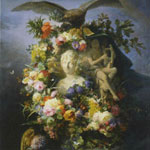
Tour Stop: 4
REIGNIER, Homage to Queen Hortense
Homage to Queen Hortense, 1856
Oil on canvas
Musée des Beaux-Arts de Lyon, Inv. A 2896
This is perhaps one of the more surprising paintings in this exhibition; I think when people think about floral still life paintings. For one thing, most people think about a rather modestly sized canvas. Even a life sized painting of a bouquet is, you know, of a certain modest scale, and here we are confronted with a towering mass of flowers, surrounding marble sculpture, topped by an eagle. It’s a painting that is rather different, certainly than anything else in this exhibition and was unique in its own time as well.
The Homage to Queen Hortense is self consciously elevated. We see an artist who’s deeply rooted in the decorative arts who is challenging themselves to go beyond that, let’s say, the industrial nature of their involvement, by seeking to elevate their subject both in size and in manner of presentation using metaphors, using flowers that refer to the qualities, the virtues, of the subject Queen Hortense.
Reignier’s painting is almost taking to the limit the notion of the flower painting that can carry symbolic meaning. Hortensias, which is the French name for hydrangeas, so that the presence of these hydrangeas is an illusion to the sitter, but there are also many flowers included that have Napoleonic references or imperial references. So this is a painting that’s pushing to almost the breaking point that the notion that a of paintings of flowers can carry this symbolic, almost literary weight. And that’s something you see contemporary artists and artists of the next generation pushing back against very forcefully.
Other painters working in a similar idiom as in Lyon’s Simon Saint-Jean who is also in this section of the exhibition, become a lightning rod for French critics such as Baudelaire and for painters such as Delacroix and Courbet, who were trying to create a painting that was more freely managed, less allusive, less literary, and more spontaneous, as we’ll see in the next section.
Certainly, there had been precedents and traditions for the idea of the floral tribute. That’s a very conventional way of presenting an homage to a figure. There’s a tradition of this in floral tributes to the Virgin Mary, even. But here, the Virgin Mary is replaced by the mother of the emperor, the late mother of the emperor. Queen Hortense was the stepdaughter of Napoleon Bonaparte. Needless to say, she was the daughter of his first wife Josephine. And Josephine had been an incredible patron of the flower painter, Redouté.
Her daughter, Hortense, had studied with Redouté and practiced flower painting herself. So it’s a very appropriate form of tribute to this rather historic woman who in addition to being the Queen of Holland during the reign of the first Napoleon was the mother of the second emperor, Louis Napoleon, who had crowned himself emperor only four years earlier. So, this painting also had a very deliberate role in reasserting the continuity of the new empire with the one that had preceded it, covering the nephew Louis Napoleon with the laurels of his uncle, Napoleon Bonaparte. Close
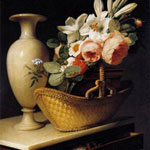
Tour Stop: 5
BERJON, Bouquet of Lilies and Roses in a Basket on a Chiffonier
Bouquet of Lilies and Roses in a Basket on a Chiffonier, 1814
Oil on canvas
Musée des Beaux-Arts de Lyon, Inv. A 181
Bouquet of Lilies and Roses in a Basket on a Chiffonier exemplifies Berjon’s idiosyncratic style in which individual moments of perception, individual textures, fragments of different kinds of surfaces are depicted in sometimes idiosyncratic conjunctions. So for example, you have the coolness of the alabaster and the marble top of the chiffonier from the warmth of the wicker basket. And it’s in exploring these opposing kinds of textures and kinds of discrepancy between seeing and touching that Berjon constructs his very individual style.
Yeah, I think it’s so true that Berjon’s art is often about touch in a surprising way. I mean, you never think about paintings as being tactile experiences, and certainly at the museum they are not tactile experiences, but I think that Berjon has an amazing ability to invite your imagined interaction with these surfaces. The wicker basket, that drawer sort of tantalizingly open in the foreground with the textures of these shelves inside. This is a painting that almost invites you to reach in and touch all these different surfaces.
The approach he takes to flowers where you really get a very loving description of their tactile qualities extends to all these different elements of the still-life, and I think that that’s something that’s quite special about Berjon and sets him apart from some of the northern painters that we saw in the first part of the exhibition.
It’s very much a painting about human experience and the open drawer alludes to our potential participation in the artist activity of arranging and gathering these flowers. It’s very much a story, rather than just a sight, a vision, that we don’t participate in.
In some of these paintings from around the turn of the 19th century, we start to see a new interest that will develop over the course of the 19th century in presenting a bouquet in a way that is surprising, that’s innovative, that brings the floral bouquet into dialogue with, as you said, other spears of human activity. That notion that we’re not just looking at a sterile bouquet sitting alone on a shelf but a bouquet that has been touched by human hands that will also engage with these other elements. Throughout the course of the exhibition, we’ll see so many artists that take up this idea of tweaking and playing with presentation of the bouquet and giving it a new complexity. Close
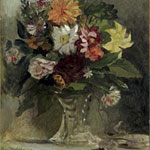
Tour Stop: 6
DELACROIX, A Vase of Flowers
A Vase of Flowers, 1833
Oil on canvas
Scottish National Gallery, Edinburgh, Purchased 1980, NG 2405
I think it’s fair to say that Delacroix’s Vase of Flowers is entirely unprecedented in exhibition. It must have seemed shockingly sketchy and unfinished at the time it was painted. And we know that it was, in this particular case, Delacroix gave it to a friend of his, a painter named Villot. Though he later created works for public exhibition, here we see Delacroix experimenting with a free manner of painting, a manner that he consciously opposed to the highly detailed manner that came before.
Delacroix is kind of a pivotal figure in this section of the exhibition because he wasn’t so much looking back to the history of still-life to 17th century precedence. He was looking at the contemporary productions of French flower painters, painters whom we’ve seen in this exhibition and really try to do something utterly new that was much less concerned with precision, with realism of how he described the flowers, and much more about the translation through the act of painting the structures of these flowers as visual phenomena.
Yes, the immediacy that Delacroix is able to convey through the quick handling of the brush is something utterly radical at the time and the results in painting is as much about the act of painting as it is about the flowers that it represents. And this is why for Delacroix and for other artists of the mid century, flower painting was a highly experimental genre, and a genre where they could seek to present new ways of thinking about painting.
It certainly isn’t because Delacroix was not as informed as these earlier painters about botany; he had a quite sophisticated knowledge of botanical structures, but he purposefully sought means to move beyond the exact transcription of these structures and to bring the painting of flowers into a much more experimental zone. And for that reason, Delacroix was a really profound influence on artists of the next generation.
Delacroix’s drawings are usually the flowers–living flowers–in gardens, rather than dead flowers or soon to be dying flowers in bouquets. He did not make preparatory drawings such as other artists did or study flowers individually. He seems to have painted the whole thing at one go, without minute preparation. That doesn’t mean that he didn’t have a painterly process; it’s just that his painterly process was not the traditional one of doing many drawings that were then assembled into a painting. For this reason, I believe this painting looks remarkably fresh, even today.
Close
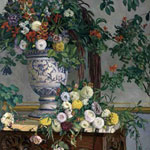
Tour Stop: 7
BAZILLE, Flowers
Flowers, 1868
Oil on canvas
Musée de Grenoble, MG 2911
When we turn to Frédéric Bazille, we’re looking now at a young artist – a contemporary of the Impressionists – although he died quite young and did not participate in their experiments, but he was a, I think, powerful influence on his contemporaries. And he was an artist that experimented a great deal in terms of format and approach to a range of genres, including floral still-life painting.
Bazille does have a very precise referent in Delacroix. We know that Bazille was very aware of Delacroix’s example and he’s patron of a man named Bruyas, who lived in Montpellier, collected Delacroix extensively. So this is kind of a painting that’s a summary of all that’s gone before it. And in also presages the experimental use of space, and color, and pattern, and surface decoration that is typical of later painters such as Bonnard or Rodin, for example.
This painting, Flowers, is highly traditional in some ways in its grandeur and its scale and the way it presents a bouquet in a quite luxurious vase. We know we’re in the presence of a certain degree of luxury here and yet he really upends or surprises our expectations of that kind of formal flower painting.
You have to look at this painting a long time to tease out what exactly is happening with all of this plant life spilling in from every margin of the painting. In addition to the principle bouquet, you can say in the upper left hand corner there’s also this mass of flowers tumbling off of the table alongside other plants that are just reaching casually into this formal still-life and bringing a very different note to this. We have incredibly humble plants—almost weeds like Oxalis growing in a little pot on the left-hand side of the console; and Cape Honeysuckle really reaching in from the right hand side of the painting. It’s this sense of a natural world that is organically participating, that sort of interacting with the bouquet is quite different than anything we’ve ever seen before in the exhibition.
And I think it’s fair to say that we won’t really be seeing anything quite like it again, because the painters that follow Bazille, some of them, tend to be more reductive in their approach to flower paintings—their compositions—abandoning the overt complexity of Bazille’s approach in favor of a much more orderly and calm kind of presentation, as we’ll see in the works by Fantin in the next section. Close
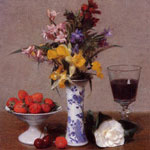
Tour Stop: 8
FANTIN-LATOUR, The Engagement Still Life
The Engagement Still Life, 1869
Oil on canvas
Musée de Grenoble, MG 2490
With Fantin-Latour, you see at least two very dominant approaches in his still-life. On the one hand, he often concentrated very closely on the bouquet and often just one kind of flower that he painted in isolation; but then on the other hand, in paintings like The Engagement Still Life, you see him practicing another kind of floral still-life in which the bouquet is set into an extremely, carefully composed tableau of objects. Here is where you see him closest to the eighteenth century still-life master, Jean-Siméon Chardin, in the deliberate, careful, precise way in which he composes this kind of still-life.
On the one hand, Chardin is an important referent, of course, in this still-life the use of the blue and white vase is remarkably similar to those of the blue and white vase in Chardin’s earlier still-life presented in Dallas. On the other hand, there’s a closeness to Whistler and the will to abstraction. The sense is so different from the sense of some other flower paintings …that we can enter the work …that we can rearrange the elements …that we are invited to rearrange the elements in the painting in our imagination, or could think of perhaps another way of arranging the elements of the still life composition. Here, in every one of Fantin’s still-lifes, no matter how different they are, there is a sense that there are definitive solution to a formal problem that’s posed by the artist, before he sets out to paint a subject and that he solves in the act of painting it.
He saw these as paintings for other painters, although they were actually quite popular and collective in their time, particularly amongst British collectors. He saw them as being the kind of painting that only other painters could properly appreciate. I think it’s quite striking that this painting, The Engagement Still Life, was the painting selected by his wife, Victoria Dubourg, who was a still-life painter herself.
This was the picture that she chose as her own engagement present from him. I think that that also speaks to the way in which Fantin-Latour saw these as paintings to be appreciated by a very sophisticated audience, namely, another painter who understood the complexity of the formal problems that he was addressing through–what is on the surface–a very plain, and one might even say mundane, assemblage of objects; but there was certainly nothing ordinary or mundane about what his expectations or ambitions were with these paintings.Close
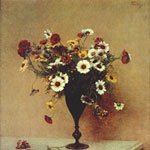
Tour Stop: 9
FANTIN-LATOUR, Chrysanthemums
Chrysanthemums, circa 1889
Oil on canvas
The Nelson-Atkins Museum of Art, Kansas City, Missouri (Purchase: William Rockhill Nelson Trust) 33-15/2
Henri Fantin-Latour, who is the greatest specialist of flower painting in the mid-nineteenth century, an artist that is, for many people associated with this genre, of principally—although, this was by no means the only genre that he practiced, or that he practiced seriously—really represents just one facet of Fantin-Latour’s artistic interest; but he produced floral still-lifes with such intensity over such a long portion of his career that he is known today as a flower painter, first and foremost.
And I think here, we are privileged to be in a room that is entirely filled with Fantins, with the exception of one painting by his bride, Victoria Dubourg, the painter who also practiced still-life. We can see that Fantin’s practice in painting flowers was not a monotonous one, in which every painting looked the same. The paintings have a surprising variety to them.
One of the things I think is fantastic in having this group of Fantin-Latours is that you get to see the very thoughtfully composed still-life grouping, a range of different objects, both natural and man-made, as well as these paintings that focus on the bouquet and often on single specimen flower. That’s something that is rather unusual in Fantin-Latour in the way that he’ll pick one species of flower and group this large bunch of it together so that he can focus almost like a botanical illustrator, on all the details of that plant. Not just the blossom but how it grows, what the foliage is like, how the stems bend this way and that way.
This sort of wealth of information you have about that kind of flower from these paintings that focus in is rather quite extraordinary, and rather different than any of his contemporaries. We know that from eyewitnesses, friends that watched Fantin-Latour paint–particularly from the country house that he shared with Victoria Dubourg, where they did much of their work–he would paint these bouquets in one or two days, just as long as the bouquet would last.
And so even in a work like Chrysanthemums, that you almost would think, “Oh, he must have worked from a photograph or from sketches in order to produce something with this level of precision,” in fact, he worked quite directly from nature. While he’s never a bravura artist who revels in his own virtuosity, there’s a kind of quiet virtuosity in painting such as Chrysanthemums, that as you said Mitchell, is a very visually satisfying experience for the viewer.
I think looking at Fantin’s still-lifes, such as Chrysanthemums, can be such a rewarding experience for the viewer if they are willing to understand formal choices that the artist was making: the choice of the almost square format; the contrast of the dark vase with the neutral background; and the way in which–unlike in The Engagement Still Life, where the elements reach almost to the borders of the frame–here, everything is gently set back just a few inches in order to produce the sense of a kind of presence in a vase that’s neutral but real.
It’s very artful …the blossoms of the chrysanthemums grow out of the vase in a kind of helter-skelter arrangement is really contrasted in a very, very self-conscious way with a slender, tapering vase that they’re held in …and by that very carefully rendered corner of the table that they sit on, how it just gives the smallest indication of space. I think it’s important to note that though Fantin often complained that he only did “flower paintings” as a way to earn money, he also said that they were a marvelous thing to paint. One cannot imagine a painter dedicating so much of their time and serious artistic effort to a genre that was merely a way of earning a once daily bread. Close
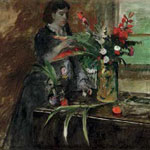
Tour Stop: 10
DEGAS, Portrait of Estelle Musson Degas
Portrait of Estelle Musson Degas, 1872
Oil on canvas
New Orleans Museum of Art, Museum Purchase through Public Subscription, 65.1
What I would notice about this painting is the question of how finished it is. It is not a conventionally finished picture as you’ve been seeing even in the works of Fantin-Latour and Bazille, or even of Delacroix. There are large areas of canvas that are left almost bare of paint, and Degas seems to be quite content to paint what he wants and in a very typically aristocratic way leave whatever he’s not interested in almost unfinished.
This isn’t a painting that Degas exhibited during his lifetime, whether he saw it as perhaps a first effort at a painting that he would have completed for exhibition, it’s hard to know. Many of the paintings that he worked on while he was visiting his family in New Orleans were left half finished, perhaps thoughts towards a more finished goal. We don’t usually think of Degas as a still life painter.
He’s so much a painter of figures, of the human form, the human face. And it’s perhaps surprising that here we’ve selected for the exhibition a painting that almost stands between genres. On one hand it’s a painting of a woman arranging a bouquet. On the other hand it’s a portrait—a portrait of a woman that Degas knew intimately well.
She was his sister-in-law as well as his cousin and he met her as a young woman and then when he came to visit his family in New Orleans encountered her again, now married to his brother, and in the intervening years she had lost her sight. So his encounter with her as a blind, or nearly blind, woman was very personally important to Degas—very moving to him—because he also was worryied these years about losing his own sight.
He had problems with his vision, and so his time spent with Estelle, and he made a number of paintings of her when he was in New Orleans, had a very personal resonance for Degas. Close
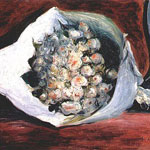
Tour Stop: 11
RENOIR, Bouquet in a Loge
Bouquet in a Loge, circa 1878–1880
Oil on canvas
Musée de l’Orangerie, Paris, RF 1960-20
Of all the Impressionist artists, Renoir was the one that spent perhaps the most effort throughout his career painting the floral still-life. It was a genre he returned to again and again, and he wrote about painting flowers as a kind of release, or an escape, from painting figures for instance. And I think that idea of flower painting and floral still-life as being a space of freedom, of experimentation is one that becomes very, very strong in the second half of the nineteenth century.
I would like to remark on the very modern elegance of the painting—the suaveness of the artist’s touch, the elegance of the choice of flowers, the white roses. They are casual, they’re profusion, but then yet they’re casually presented, wrapped in some paper and left on a chair with a velvet cushion. It speaks to a very modern lifestyle as well as being a very innovative kind of painting.
This idea that by focusing on a subject that is not narrative, it’s not literary, the painter has a kind of unparalleled freedom and can really focus on the act of painting—that’s something that I think Renoir’s expressing, that other artists also expressed during these years.
I also would like to point out the fact that this almost monochrome painting, or the restriction of the palette, and Renoir who is known as the master of color and could use the most thrilling yellows and oranges in his paintings that the rather subdued palette perhaps might have something to do with Manet, who was an inspiration for many of the Impressionists, but also represented a polarity in flower painting, where artists really use the flower and chose the flowers in a way with the color of the flower itself even before they set brushes to canvas.
At first glance, we don’t understand exactly what is happening here. We see this bunch of rose painted very quickly, very spontaneously, and the setting is very secondary but as we look and start to understand that this bunch of roses is wrapped in white paper for presentation and that it’s sitting on a red velvet chair, the implied narrative starts to come together. We say, “Ah, this is a bouquet that’s been given to a woman in a theater, and she set down this bouquet …perhaps she’s moving around talking.” There’s this hint at a narrative that is both modern, more of a modern space, but more so something just so hinted at and suggested.
This is a painting that’s really about the intimacy about a relationship or an implied relationship between a man and a woman carried out through private meetings using flowers and bouquets to convey private messages, perhaps of love, or affection but in a very public setting. So it’s also a painting about looking and perceiving, as well as about representation.
And it’s possible that Renoir made this painting while he was preparing a larger subject in a modern genre painting that showed a beautiful fashionable woman at the theater holding just such a bouquet, sitting in a chair like this; and perhaps he painted this still-life as he was preparing for that and in working up just this still life component, he had a great deal of freedom in how he approached that element of what become a more tightly controlled composition later. Close
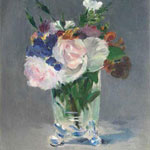
Tour Stop: 12
MANET, Flowers in a Crystal Vase
Flowers in a Crystal Vase, circa 1882
Oil on canvas
National Gallery of Art, Washington, D.C., Ailsa Mellon Bruce Collection, 1970.17.37
We’re also commenting on the small scale and the power of this painting despite its very small scale. It is very thoughtfully painted, very purposefully painted; every brush stroke has a purpose in constructing or suggesting a form. It’s important to also stress the circumstance under which Manet in his final years (and ill) painted these small still lifes of flowers that were brought in by friends and he gave them pictures of flowers as presents and mementoes. So, there is another sense of the intimacy involved in flower painting.
I love the way that he describes this thick heavy glass vase. You can almost feel its weight. And when you look closely at how he constructs it it’s quite a minimalist approach. That grey paint that he uses to describe the background carves out the contours of the sides of the vase and in the translucent glass sides of the vase you are really seeing straight through to the bare primed canvas underneath, which he leaves utterly bare so that you have the sense of this transparency—this translucency.
So then in the thick feet he brings in the opaque paint again to convey that heaviness of the glass where it’s sort of reflecting the flowers above. It’s such a wonderful performance of painting with an economy of means. I think that as an example of this wonderful series of flower subjects that Manet made during his last year of life, it really conveys the way he turned to this focused subject and brought an incredible intensity and artistic skill and attention to the subject.
There is an awe inspiring poignancy to the amount of sheer skill that this artist was able to bring to such a restricted subject and to bring it to life in such a moving way. Even if one didn’t know that this was one of his last paintings one would still be struck by the kind of discrepancy between the great powers of observation and application of the artist and the modesty of the subject he chose to depict. And Manet would often depict very modest subjects—pads of butter, stalks of asparagus—encouraging us to see in these simple objects as well as the meaning and beauty of the world of nature as the painter was able to celebrate it with his brush. Close
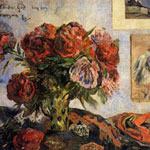
Tour Stop: 13
GAUGUIN, Still Life with Peonies
Still Life with Peonies, 1884
Oil on canvas
National Gallery of Art, Washington, D.C., Collection of Mr. and Mrs. Paul Mellon, 1995.47.10
Once again looking at Gauguin’s Still Life with Peonies, we’re seeing a painting of flowers that was given as a gift. It has quite a prominent inscription in the upper left hand corner to Gauguin’s brother-in-law. And this is an example of the sophisticated and more and more complex still life subjects that the Impressionist painters were making in the early 1880s.
This was a moment when you see many of the Impressionist painters really looking to still life, and to floral still life in particular, as a place where they could experiment and try new formats and certainly Gauguin is doing that as well. This is the first painting in which he included other works of art as part of the background of his still life—in this case two works from his own art collection. And the drawing on the right-hand side is of a ballerina was a gift to Gauguin from Degas, from Edgar Degas, work for which he exchanged one of his own pictures. Though, again, that role of the sort of bouquet, or the painting of the bouquet, as part of an artistic exchange is once again referenced here.
Yes, this is very much a statement painting about Gauguin ascribing himself into the tightest and innermost circle of the Impressionists.
Peonies were a very fashionable flower, and we see it as a subject that both Manet and many of the Impressionist artists loved to paint. And Gauguin’s approach is rather different. The lightness and the delicacy of the peonies here transformed into something much more mass-y, much more solid. There is a kind of a fullness and heaviness to how Gauguin describes the poenies that’s quite different from Manet’s approach to the same subject. But Gauguin loves the visual dialogue between the flowers—between the textiles in the foreground—and this is Gauguin’s rather unique and idiosyncratic approach to the subject of the floral still life.
And I think the rather highly key colors and chromatic composition also point the way to his later post-Impressionist still lifes.
At this point, very much under the influence of Pissarro, who was his great mentor, he was working from nature. But, increasingly in the later 1880s and certainly in the 1890s, he made it very clear that he did not see himself as working directly from nature but from his memory—from his visual experience filtered through his imagination. Amongst the Impressionists Gauguin is certainly one of the artists who would go on to develop a very unusual approach to a floral still life painting, and he would turn to it a number of times throughout his career as we will see later in the exhibition. Close
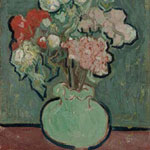
Tour Stop: 14
VAN GOGH, Vase of Flowers
Vase of Flowers, summer 1890
Oil on canvas
Van Gogh Museum, Amsterdam (Vincent van Gogh Foundation), S109V/1962
Vincent van Gogh really discovered flower painting at the same time that he discovered Delacroix, Impressionism, and this great tradition of color in French 19th century painting. When he moved to Paris in 1886, he made a glorious sequence of floral still lifes between the summer of 1886 and 1887, some of which you can see here, and he credited that experience of concentrating on flower painting with teaching him how to paint in color, an approach that he then of course took into his landscape painting, his figure painting and so on.
But this picture of a vase of flowers, from the summer of 1890 toward the end of his life, is really quite different in its approach. The pallet of course is quite subdued and reduced relative to these earlier pictures, and it’s a painting that he painted in a rather different context. Not in a context of discovery and rebirth, but rather when he was recovering from his own mental break down and seeking a way to move forward.
This is a highly stylized painting that shows in its flattening of forms and what’s been called cloisonnism, or this heavy outlining, of influence of Japanese art. Paradoxically, it’s a work by a Dutch born painter who is looking to Japan for inspiration working in a genre that had, by the time he was painting, become a dominant genre for expressing artistic experimentation in France.
It’s also worth noting that when he painted this painting he was staying at the home of Dr. Gachet who was treating him for his depression. And Gachet was not only a doctor, but he also was a major collector of Impressionist painting. He knew the Impressionists, and painted himself, and had collected quite an important collection that today is at the Musée d’Orsay. Amongst the works that Gachet owned, that we know that van Gogh is looking at, that he wrote about in letters, were two early floral still lifes by Paul Cézanne.
And this work seems very, very closely related to those early Cézanne paintings, which are quite awkward, very heavy, very bulbous. And it was a moment when Cézanne was struggling with this motif, this natural subject, and it’s quite interesting to see van Gogh, who seemed to have such an easy and organic relationship to the motif of flowers when he first sort of painted them in 1886, working through—thinking through—the example of Cézanne and these early works in which Cézanne struggled with that motif.
This sense that van Gogh is painting one removed from the motif of flowers itself and is thinking about how another painter, who he greatly admired painted flowers. The internal dialogue that’s captured in this painting is really important as well. Close
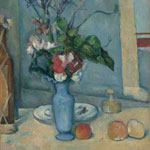
Tour Stop: 15
CÉZANNE, The Blue Vase
The Blue Vase, circa 1889–1890
Oil on canvas
Musée d’Orsay, Paris, Bequest of Comte Isaac de Camondo, 1911, RF 1973
Blue Vase by Cézanne, one of his master pieces in the genre of flower painting, is also marked by an extreme stylization by the development of Impressionist ideas in the service of a more abstract kind of painting that’s more about formal relationships than it is about botanical specificity.
Earlier in the exhibition we saw Paul Cézanne struggling with the motif of flowers and failing to (in his mind) realize it in cutting apart the canvas and abandoning that effort. And we know that because he had a difficult time painting flowers as quickly as the motif demanded. He actually even used paper flowers and painted paper flowers rather than cut natural flowers, because he just couldn’t work quickly enough to capture them before they wilted.
But here in the Blue Vase, I think we see Cézanne coming to a more resolved relationship to this motif, and certainly it was a subject that he returned to again and again. So he was not defeated by this motif in the long term but defined his own path to painting flowers. His approach is not one of meticulous transcription of the structures of flowers. Certainly, we can recognize the purple irises in the bouquets, but many of the flowers here are not described with enough specificity to know what species he was painting.
A bouquet of flowers is almost an impossibly complex structure to translate. Cézanne works outward from that complexity and builds layers of ambiguity and spatial confusion into the still life as a whole, and we see that in the rather unclear way in which the planes of the room, the walls of the room behind this bouquet, are treated where we don’t know quite where we are in this space and how the different elements in this interior relate to each other or to the table in the foreground. But that’s very much the task that Cézanne sets for himself in the later 1880s and 1890s, and we see very similar complexity of spaces in the works of Pissarro during this time and later also in the art of Henri Matisse.
I would say that there is a certain stubbornness with which Cézanne refuses to do certain things that he no doubt was able to do pictorially, such as choose a different background color for the wall—it’s pretty close to the color of the vase. He seems unwilling to want to draw a true horizontal or vertical line, but yet he insists on there being almost horizontal and almost vertical lines—not diagonal, but not horizontal, not vertical. There’s a certain degree with which Cézanne is making you aware of the difficulty of making a painting of a floral still life and also of seeing in general.
You see that kind of insistence on the difficulties of both perceiving and representing, and I think particularly you see it around the perimeter of the blue vase where there’s this halo of uncertainty. How exactly does the vase meet the plate behind it? How does the vase sit on the table? How does the neck of the vase—is it profiled against that wall behind it, which you say is that same blue color? And, so in particular the zones where forms meet you really see Cézanne insisting on the complexities of seeing and representing. Close
Tour Stop: 16
MATISSE, Still Life with Pascal’s “Pensées”
Still Life with Pascal’s “Pensées,” 1924
Oil on canvas
Minneapolis Institute of Arts, Gift of Ruth and Bruce Dayton, 2010.37
Throughout the exhibition we’ve seen a number of artists who like to include books in their floral still life paintings. It’s something that Pissarro did often, we’ve seen it in a painting by Berjon and a painting by Bonnard, and here we see Matisse also including a book as a very prominent component of this still life painting. It’s both a recurring theme in the genre of the floral still life, and it means something very specific to Matisse in this instance.
And that’s because Pascal is seen as for comparing the capacity of imagination and the capacity of nature to produce.
The book is The Pensées by Blaise Pascal who was a seventeenth century philosopher, The Pensées, which is translated as “thoughts,” is a collection of related yet disjointed essays on a variety of different topics about human nature, mankind, the role of nature. And the essay, or fragment as they were called, that perhaps Matisse was reading as he sat there before his bunch of flowers looking out at nature, was one in which Pascal talks about the capacity, the power of the natural world to supply endless material for contemplation—for thought.
In 1924 Henri Matisse was living in Nice in an apartment looking out over the Mediterranean and during this year he made a really exciting group of still life paintings, quite a number of which were floral still lifes. There are two here in the exhibition. This painting of the still life with Pascal’s Pensées is a particularly poignant example of his approach to still life painting during this period.
There is an ideal harmony and order to the picture. It’s so carefully constructed and painted. It’s not over elaborate. It’s very direct in its choice of what to transcribe, and what is being transcribed are things that are really pleasant and useful. You know, the beach outside, the wind gently wrestling the curtains, the flowers which have been very carefully and lovingly placed into the blue and white vase, the small cup of coffee with its spoon ready for us to pick up and stir it, and the volume of Pascal laying on the table just over its edge inviting us to figuratively, of course, open it, and join with the artist in meditating on existence. Close
Tour Stop: 17
BONNARD, The Poppies
The Poppies, 1918
Oil on canvas
Musée National d’Art Moderne, Paris (AM.4530.P), on deposit at the Musée des Beaux-Arts et d’Archéologie de Besançon (Db.970.1.20)
Bonnard, like Odilon Redon, made very early floral still lifes and then abandoned this genre for many years of his career and only came back to it when he was older in his forties, then continued to make flower paintings for the rest of his life. You have a sense that this was a subject that became increasingly rewarding to him the more he painted it. And this very unusual, tall, narrow image is a wonderful example of how much his canvases could be full of light, full of immediacy, full of that sense of a bouquet spontaneously and freshly observed, even as he created them very meticulously in his studio.
He talked about wanting to paint subjects as if you sort of walked into a room and surprised them, as if you came upon them unawares. And I think that’s something he does beautifully well in this painting; even though we know that that was in no way the way that he worked. He did not have that quick spontaneous way of painting, and yet he is able to conjure that illusion of spontaneity, of immediacy, in these wonderfully late still lifes.
There’s a certain generosity that’s like a metaphor that one could use with regard to these floral still lifes—of the generosity of the artist presenting something to our view. And I think this is underscored exceptionally beautifully in the Bonnard by the beautiful light of the painting, and the illumination, and the fact that everywhere one looks there’s something—color, brushstroke, formal elements that delights the eye.
I would start by noting the inclusion of the mirror in the The Poppies, by Pierre Bonnard because all through the exhibition, we’ve been seeing painters striving to represent nature …to interpret nature …and hold up a mirror to nature, but no one has done it at literally as Bonnard; commenting on the nature of representation itself by including the mirror and that’s doubly making us a wonderful still-life of two bouquets rather than one.
Certainly, Pierre Bonnard is another example of an artist who both readily admitted his own struggles to capture a motif as complex as a bouquet, and he talked about how he became lost in those details if he tried to paint it directly from nature and therefore he worked almost exclusively, not just in floral still life but in general through making sketches from life and watercolors but then going back to his studio and working both from his sketches and from his memory.
So here we have an artist who acknowledges his own challenges with these kind of complex motifs, and yet like Cézanne, or Pissarro, or Matisse, when he goes to construct this floral still life, he magnifies and multiplies those complexities, for instance, as you said, by including this mirror so that the space and the subject becomes more ambiguous, more hard to understand visually. I think that that visual enjoyment that’s offered by these complex, ambiguous spaces is very much something that Bonnard shared with Cézanne, and Matisse, and many of the other artists that he was observing. Close

